Distant Interactions, Power, and Environmental Justice in Protected Area Governance: A Telecoupling Perspective
Abstract
1. Introduction
2. Environmental Justice in Telecoupled Systems
2.1. Equity and Justice: A Three-Dimensional Understanding
2.2. Environmental Justice in Conservation Contexts
2.3. Environmental Justice and Globalization
2.4. Telecoupling: A Networked Approach of Globalization
2.5. PAs as Networked Social Spaces of Justice and Injustice
2.6. Barriers, Opportunities, and Transformation Options for EJ
3. Approach, Materials, and Methods
4. Results
4.1. Masoala National Park, Madagascar
4.2. Tunari National Park, Bolivia
4.3. Nech Sar National Park, Ethiopia
4.4. Galapagos National Park and Marine Resource Reserve, Ecuador
5. Discussion
5.1. Barriers to Equitable PA Governance
5.2. Resistance Actions
5.3. Telecouplings and Environmental Justice: A Question of Distance?
6. Conclusions
Author Contributions
Funding
Acknowledgments
Conflicts of Interest
References
- Thomas, C.D.; Gillingham, P.K.; Bradbury, R.B.; Roy, D.B.; Anderson, B.J.; Baxter, J.M.; Bourn, N.A.D.; Crick, H.Q.P.; Findon, R.A.; Fox, R.; et al. Protected areas facilitate species’ range expansions. Proc. Natl. Acad. Sci. USA 2012, 109, 14063–14068. [Google Scholar] [CrossRef] [PubMed]
- UNEP-WCMC; IUCN. Protected Planet Report 2016; UNEP-WCMC: Gland, Switzerland; IUCN: Cambridge, UK, 2016. [Google Scholar]
- Mace, G.M.; Cramer, W.; Díaz, S.; Faith, D.P.; Larigauderie, A.; Le Prestre, P.; Palmer, M.; Perrings, C.; Scholes, R.J.; Walpole, M.; et al. Biodiversity targets after 2010. Curr. Opin. Environ. Sustain. 2010, 2, 3–8. [Google Scholar] [CrossRef]
- Butchart, S.H.M.; Walpole, M.; Collen, B.; van Strien, A.; Scharlemann, J.P.W.; Almond, R.E.A.; Baillie, J.E.M.; Bomhard, B.; Brown, C.; Bruno, J.; et al. Global Biodiversity: Indicators of Recent Declines. Science 2010, 328, 1164–1168. [Google Scholar] [CrossRef] [PubMed]
- Rockstrom, J.; Steffen, W.; Noone, K.; Persson, A.; Chapin, F.S.; Lambin, E.F.; Lenton, T.M.; Scheffer, M.; Folke, C.; Schellnhuber, H.J.; et al. A safe operating space for humanity. Nature 2009, 461, 472–475. [Google Scholar] [CrossRef] [PubMed]
- Wilson, E.O. Half-Earth: Our Planet’s Fight for Life; Liveright Publishing Corporation: New York, NY, USA; London, UK, 2016. [Google Scholar]
- Mascia, M.B.; Pailler, S. Protected area downgrading, downsizing, and degazettement (PADDD) and its conservation implications. Conserv. Lett. 2011, 4, 9–20. [Google Scholar] [CrossRef]
- Laurance, W.F.; Carolina Useche, D.; Rendeiro, J.; Kalka, M.; Bradshaw, C.J.A.; Sloan, S.P.; Laurance, S.G.; Campbell, M.; Abernethy, K.; Alvarez, P.; et al. Averting biodiversity collapse in tropical forest protected areas. Nature 2012, 489, 290–294. [Google Scholar] [CrossRef] [PubMed]
- Brockington, D.; Igoe, J. Eviction for Conservation: A Global Overview. Conserv. Soc. 2006, 4, 424–470. [Google Scholar]
- West, P.; Igoe, J.; Brockington, D. Parks and Peoples: The Social Impact of Protected Areas. Annu. Rev. Anthropol. 2006, 35, 251–277. [Google Scholar] [CrossRef]
- Almudi, T.; Berkes, F. Barriers to empowerment: Fighting eviction for conservation in a southern Brazilian protected area. Local Environ. 2010, 15, 217–232. [Google Scholar] [CrossRef]
- Duffy, R. Waging a war to save biodiversity: The rise of militarized conservation. Int. Aff. 2014, 90, 819–834. [Google Scholar] [CrossRef]
- Ramutsindela, M. The Contours of Political Transformation and Conservation Areas in Southern Africa. Geogr. Compass 2008, 2, 359–374. [Google Scholar] [CrossRef]
- Bennett, N.J.; Roth, R.; Klain, S.C.; Chan, K.M.A.; Clark, D.A.; Cullman, G.; Epstein, G.; Nelson, M.P.; Stedman, R.; Teel, T.L.; et al. Mainstreaming the social sciences in conservation. Conserv. Biol. 2017, 31, 56–66. [Google Scholar] [CrossRef] [PubMed]
- Reed, M.S. Stakeholder participation for environmental management: A literature review. Biol. Conserv. 2008, 141, 2417–2431. [Google Scholar] [CrossRef]
- Martin, A. Just Conservation. Biodiversity, Well-Being and Sustainability; Earthscan, Routledge: Oxford, UK, 2017. [Google Scholar]
- Oberlack, C.; LaHaela Walter, P.; Schmerbeck, J.; Tiwari, B. Institutions for sustainable forest governance: Robustness, equity, and cross-level interactions in Mawlyngbna, Meghalaya, India. Int. J. Commons 2015, 9, 670–697. [Google Scholar] [CrossRef]
- Andrade, G.S.M.; Rhodes, J.R. Protected Areas and Local Communities: An Inevitable Partnership toward Successful Conservation Strategies? Ecol. Soc. 2012, 17. [Google Scholar] [CrossRef]
- Oldekop, J.A.; Holmes, G.; Harris, W.E.; Evans, K.L. A global assessment of the social and conservation outcomes of protected areas. Conserv. Biol. 2016, 30, 133–141. [Google Scholar] [CrossRef] [PubMed]
- Schlosberg, D. Theorising environmental justice: The expanding sphere of a discourse. Environ. Politics 2013, 22, 37–55. [Google Scholar] [CrossRef]
- Liu, J.; Hull, V.; Batistella, M.; DeFries, R.; Dietz, T.; Fu, F.; Hertel, T.W.; Izaurralde, R.C.; Lambin, E.F.; Li, S.; et al. Framing Sustainability in a Telecoupled World. Ecol. Soc. 2013, 18. [Google Scholar] [CrossRef]
- Eakin, H.; DeFries, R.; Kerr, S.; Lambin, E.F.; Liu, J.; Marcotullio, P.J.; Messerli, P.; Rueda, X.; Swaffield, S.R.; Wicke, B.; et al. Significance of Telecoupling for Exploration of Land-Use Change. In Rethinking Global Land Use in an Urban Era; Seto, K., Reenberg, A., Eds.; MIT Press: Cambridge, MA, USA, 2014; pp. 141–162. ISBN 978-0-262-02690-1. [Google Scholar]
- Oberlack, C.; Boillat, S.; Brönnimann, S.; Gerber, J.-D.; Heinimann, A.; Ifejika Speranza, C.; Messerli, P.; Rist, S.; Wiesmann, U. Polycentric governance in telecoupled resource systems. Ecol. Soc. 2018, 23. [Google Scholar] [CrossRef]
- Kimmich, C. Linking action situations: Coordination, conflicts, and evolution in electricity provision for irrigation in Andhra Pradesh, India. Ecol. Econ. 2013, 90, 150–158. [Google Scholar] [CrossRef]
- Walker, G. Beyond Distribution and Proximity: Exploring the Multiple Spatialities of Environmental Justice. Antipode 2009, 41, 614–636. [Google Scholar] [CrossRef]
- Rawls, J. A Theory of Justice; Belknap: Cambridge, MA, USA, 1971. [Google Scholar]
- Sen, A. The Idea of Justice; Allen Lane & Harvard University Press: Cambridge, MA, USA, 2009. [Google Scholar]
- Fraser, N. Identity, Exclusion, and Critique: A Response to Four Critics. Eur. J. Political Theory 2007, 6, 305–338. [Google Scholar] [CrossRef]
- Fraser, N. Recognition without Ethics? Theory Cult. Soc. 2001, 18, 21–42. [Google Scholar] [CrossRef]
- Honneth, A. Recognition or Redistribution? Theory Cult. Soc. 2001, 18, 43–55. [Google Scholar] [CrossRef]
- Young, I.M. Justice and the Politics of Difference; Princeton University Press: Princeton, NJ, USA, 1990. [Google Scholar]
- Taylor, D.E. The Rise of the Environmental Justice Paradigm: Injustice Framing and the Social Construction of Environmental Discourses. Am. Behav. Sci. 2000, 43, 508–580. [Google Scholar] [CrossRef]
- Mohai, P.; Pellow, D.; Roberts, J.T. Environmental Justice. Annu. Rev. Environ. Resour. 2009, 34, 405–430. [Google Scholar] [CrossRef]
- Agyeman, J.; Schlosberg, D.; Craven, L.; Matthews, C. Trends and Directions in Environmental Justice: From Inequity to Everyday Life, Community, and Just Sustainabilities. Annu. Rev. Environ. Resour. 2016, 41, 321–340. [Google Scholar] [CrossRef]
- Schlosberg, D. Reconceiving Environmental Justice: Global Movements And Political Theories. Environ. Politics 2004, 13, 517–540. [Google Scholar] [CrossRef]
- Gottlieb, R. Where We Live, Work, Play and Eat: Expanding the Environmental Justice Agenda. Environ. Justice 2009, 2, 7–8. [Google Scholar] [CrossRef]
- Martin, A.; McGuire, S.; Sullivan, S. Global environmental justice and biodiversity conservation. Geogr. J. 2013, 179, 122–131. [Google Scholar] [CrossRef]
- Sikor, T. The Justices and Injustices of Ecosystem Services; Routledge: Oxford, UK, 2014. [Google Scholar]
- De Jonge, B. What is Fair and Equitable Benefit-sharing? J. Agric. Environ. Ethics 2011, 24, 127–146. [Google Scholar] [CrossRef]
- McDermott, M.; Mahanty, S.; Schreckenberg, K. Examining equity: A multidimensional framework for assessing equity in payments for ecosystem services. Environ. Sci. Policy 2013, 33, 416–427. [Google Scholar] [CrossRef]
- Berkes, F. Evolution of co-management: Role of knowledge generation, bridging organizations and social learning. J. Environ. Manag. 2009, 90, 1692–1702. [Google Scholar] [CrossRef] [PubMed]
- Gorenflo, L.J.; Romaine, S.; Mittermeier, R.A.; Walker-Painemilla, K. Co-occurrence of linguistic and biological diversity in biodiversity hotspots and high biodiversity wilderness areas. Proc. Natl. Acad. Sci. USA 2012, 109, 8032–8037. [Google Scholar] [CrossRef] [PubMed]
- Martin, A.; Coolsaet, B.; Corbera, E.; Dawson, N.M.; Fraser, J.A.; Lehmann, I.; Rodriguez, I. Justice and conservation: The need to incorporate recognition. Biol. Conserv. 2016, 197, 254–261. [Google Scholar] [CrossRef]
- Zafra-Calvo, N.; Pascual, U.; Brockington, D.; Coolsaet, B.; Cortes-Vazquez, J.A.; Gross-Camp, N.; Palomo, I.; Burgess, N.D. Towards an indicator system to assess equitable management in protected areas. Biol. Conserv. 2017, 211, 134–141. [Google Scholar] [CrossRef]
- Schreckenberg, K.; Franks, P.; Martin, A.; Lang, B. Unpacking equity for protected area conservation. Parks 2016, 22, 11–26. [Google Scholar] [CrossRef]
- Dawson, N.; Martin, A.; Danielsen, F. Assessing Equity in Protected Area Governance: Approaches to Promote Just and Effective Conservation. Conserv. Lett. 2017, 11, 1–8. [Google Scholar] [CrossRef]
- Franks, P.; Martin, A.; Schreckenberg, K. From Livelihoods to Equity for Better Protected Area Conservation; International Institute for Environment and Development Briefing: London, UK, 2016. [Google Scholar]
- Agyeman, J.; Carmin, J. Environmental Inequalities Beyond Borders: Local Perspectives on Global Injustices; MIT Press: Cambridge, MA, USA, 2011. [Google Scholar]
- Sikor, T.; Newell, P. Globalizing environmental justice? Geoforum 2014, 54, 151–157. [Google Scholar] [CrossRef]
- Miranda, M.L.; Hastings, D.A.; Aldy, J.E.; Schlesinger, W.H. The Environmental Justice Dimensions of Climate Change. Environ. Justice 2011, 4, 17–25. [Google Scholar] [CrossRef]
- Guha, R. Radical American Environmentalism and Wilderness Preservation: A Third World Critique. Environ. Ethics 1989, 11, 71–83. [Google Scholar] [CrossRef]
- Martinez-Alier, J. The environmentalism of the poor. Geoforum 2014, 54, 239–241. [Google Scholar] [CrossRef]
- Holifield, R. Environmental Justice and Political Ecology. In The Routledge Handbook of Political Ecology; Perreault, T., Bridge, G., McCarthy, J., Eds.; Routledge: Oxford, UK; New York, NJ, USA, 2015; pp. 585–597. [Google Scholar]
- Nancy, F. Who Counts? Dilemmas of Justice in a Postwestphalian World. Antipode 2010, 41, 281–297. [Google Scholar] [CrossRef]
- Buller, J. State spatiality in an era of global and regional interdependence: The linkage governance approach. Comp. Eur. Politics 2018, 16, 224–248. [Google Scholar] [CrossRef]
- Painter, J. Territoire et réseau: Une fausse dichotomie? [Territory and network: A false dichotomy?]. In Territoires, Territorialité, Territorialisation: Controverses et Perspectives; Vanier, M., Ed.; Presses Universitaires de Rennes: Rennes, France, 2009; pp. 57–66. [Google Scholar]
- Gibson-Graham, J.K. Beyond Global vs. Local: Economic Politics Outside the Binary Frame. In Geographies of Power: Placing Scale; Herod, A., Wright, M.W., Eds.; Blackwell Publishers Ltd: Oxford, UK, 2002; pp. 25–60. ISBN 9780470773406. [Google Scholar]
- Herod, A. Scale: The local and the global. In Key Concepts in Geography; Clifford, N.J., Holloway, S.L., Rice, S.P., Gill, V., Eds.; Sage Publishers: Los Angeles, CA, USA; London, UK; New Delhi, India; Singapore; Washington, DC, USA, 2009; pp. 217–235. [Google Scholar]
- Latour, B. Nous N’avons Jamais été Modernes. Essai D’anthropologie Symétrique; La découverte: Paris, France, 1997. [Google Scholar]
- Sikor, T.; Auld, G.; Bebbington, A.J.; Benjaminsen, T.A.; Gentry, B.S.; Hunsberger, C.; Izac, A.M.; Margulis, M.E.; Plieninger, T.; Schroeder, H.; et al. Global land governance: From territory to flow? Curr. Opin. Environ. Sustain. 2013, 5, 522–527. [Google Scholar] [CrossRef]
- Beck, U. Risk Society: Towards a New Modernity; SAGE Publications Ltd.: Los Angeles, CA, USA; London, UK; New Delhi, India; Singapore; Washington, DC, USA, 1992. [Google Scholar]
- Young, I.M. Responsibility and global justice: A social connection model. Soc. Philos. Policy 2006, 23, 102–130. [Google Scholar] [CrossRef]
- Lenschow, A.; Newig, J.; Challies, E. Globalization’s limits to the environmental state? Integrating telecoupling into global environmental governance. Environ. Politics 2016, 25, 136–159. [Google Scholar] [CrossRef]
- Liu, J.; Dietz, T.; Carpenter, S.R.; Alberti, M.; Folke, C.; Moran, E.; Pell, A.N.; Deadman, P.; Kratz, T.; Lubchenco, J.; et al. Complexity of Coupled Human and Natural Systems. Science 2007, 317, 1513–1516. [Google Scholar] [CrossRef] [PubMed]
- Meyfroidt, P.; Rudel, T.K.; Lambin, E.F. Forest transitions, trade, and the global displacement of land use. Proc. Natl. Acad. Sci. USA 2010, 107, 20917–20922. [Google Scholar] [CrossRef] [PubMed]
- Eakin, H.; Rueda, X.; Mahanti, A. Transforming governance in telecoupled food systems. Ecol. Soc. 2017, 22. [Google Scholar] [CrossRef]
- Ostrom, E. Polycentric systems for coping with collective action and global environmental change. Glob. Environ. Chang. 2010, 20, 550–557. [Google Scholar] [CrossRef]
- Ostrom, E. A General Framework for Analyzing Sustainability of Social-Ecological Systems. Science 2009, 325, 419–422. [Google Scholar] [CrossRef] [PubMed]
- Ostrom, E. Background on the Institutional Analysis and Development Framework. Policy Stud. J. 2011, 39, 7–27. [Google Scholar] [CrossRef]
- Clément, F. For critical social-ecological system studies: Integrating power and discourses to move beyond the right institutional fit. Environ. Conserv. 2013, 40, 1–4. [Google Scholar] [CrossRef]
- Isaac, J.C.; Bermeo, N.; Levi, M.; Baumgartner, F.R.; Keohane, R.O.; Axelrod, R.; Fine, B.; Schwartz-Shea, P.; Mansbridge, J. Beyond the Tragedy of the Commons A Discussion of “Governing the Commons: The Evolution of Institutions for Collective Action”. Perspect. Politics 2010, 8, 569–593. [Google Scholar] [CrossRef]
- Friis, C.; Nielsen, J.Ø.; Otero, I.; Haberl, H.; Hostert, P. From teleconnection to telecoupling: Taking stock of an emerging framework in land system science. J. Land Use Sci. 2015, 4248, 1–23. [Google Scholar] [CrossRef]
- Maxwell, S.L.; Fuller, R.A.; Brooks, T.M.; Watson, J.E.M. Biodiversity: The ravages of guns, nets and bulldozers. Nature 2016, 536, 143–145. [Google Scholar] [CrossRef] [PubMed]
- Weinzettel, J.; Hertwich, E.G.; Peters, G.P.; Steen-Olsen, K.; Galli, A. Affluence drives the global displacement of land use. Glob. Environ. Chang. 2013, 23, 433–438. [Google Scholar] [CrossRef]
- Lenzen, M.; Moran, D.; Kanemoto, K.; Foran, B.; Lobefaro, L.; Geschke, A. International trade drives biodiversity threats in developing nations. Nature 2012, 486, 109–112. [Google Scholar] [CrossRef] [PubMed]
- Liu, J.; Dou, Y.; Batistella, M.; Challies, E.; Connor, T.; Friis, C.; Millington, J.D.A.; Parish, E.; Romulo, C.L.; Silva, R.F.B.; et al. Spillover systems in a telecoupled Anthropocene: Typology, methods, and governance for global sustainability. Curr. Opin. Environ. Sustain. 2018, 33, 58–69. [Google Scholar] [CrossRef]
- Carrasco, L.R.; Chan, J.; McGrath, F.L.; Nghiem, L.T.P. Biodiversity conservation in a telecoupled world. Ecol. Soc. 2017, 22. [Google Scholar] [CrossRef]
- Miller, D.C.; Agrawal, A.; Roberts, J.T. Biodiversity, Governance, and the Allocation of International Aid for Conservation. Conserv. Lett. 2013, 6, 12–20. [Google Scholar] [CrossRef]
- Balmford, A.; Green, J.M.H.; Anderson, M.; Beresford, J.; Huang, C.; Naidoo, R.; Walpole, M.; Manica, A. Walk on the Wild Side: Estimating the Global Magnitude of Visits to Protected Areas. PLoS Biol. 2015, 13, 1–6. [Google Scholar] [CrossRef] [PubMed]
- Myers, N.; Mittermeier, R.A.; Mittermeier, C.G.; da Fonseca, G.A.B.; Kent, J. Biodiversity hotspots for conservation priorities. Nature 2000, 403, 853–858. [Google Scholar] [CrossRef] [PubMed]
- Gissibl, B.; Höhler, S.; Kupper, P. Civilizing Nature: National Parks in Global Historical Perspective; Berghahn Books: New York, NY, USA; Oxford, UK, 2012; ISBN 978-1-78238-908-8. [Google Scholar]
- Roberts, S.M.; Jones III, J.P.; Fröhling, O. NGOs and the globalization of managerialism: A research framework. World Dev. 2005, 33, 1845–1864. [Google Scholar] [CrossRef]
- Sodikoff, G. The Low-Wage Conservationist: Biodiversity and Perversities of Value in Madagascar. Am. Anthropol. 2009, 111, 443–455. [Google Scholar] [CrossRef]
- Fairhead, J.; Leach, M.; Scoones, I. Green Grabbing: A new appropriation of nature? J. Peasant Stud. 2012, 39, 237–261. [Google Scholar] [CrossRef]
- Peluso, N.L.; Lund, C. New frontiers of land control: Introduction. J. Peasant Stud. 2011, 38, 667–681. [Google Scholar] [CrossRef]
- Harvey, D. A Brief History of Neoliberalism; Oxford University Press: Oxford, UK, 2005; ISBN 0-19-162294-X. [Google Scholar]
- Brockington, D.; Duffy, R.; Igoe, J. Nature Unbound: Conservation, Capitalism and the Future of Protected Areas; Earthscan: London, UK; Sterling, VA, USA, 2008. [Google Scholar]
- Fraser, N. Injustice at Intersecting Scales: On “Social Exclusion” and the “Global Poor”. Eur. J. Soc. Theory 2010, 13, 363–371. [Google Scholar] [CrossRef]
- Fraser, N. A triple movement? Parsing the Politics of Crisis after Polanyi. In Beyond Neoliberalism. Approaches to Social Inequality and Difference; Burchardt, M., Kirn, G., Eds.; Palgrave Macmillan: London, UK, 2017; pp. 29–42. [Google Scholar]
- Liu, J.; Hull, V.; Luo, J.; Yang, W.; Liu, W.; Viña, A.; Vogt, C.; Xu, Z.; Yang, H.; Zhang, J.; et al. Multiple telecouplings and their complex interrelationships. Ecol. Soc. 2015, 20, 44. [Google Scholar] [CrossRef]
- Mace, G.M. Whose conservation? Science 2014, 345, 1558–1560. [Google Scholar] [CrossRef] [PubMed]
- Dudley, N. Guidelines for Applying Protected Area Management Categories; IUCN: Gland, Switzerland, 2008. [Google Scholar]
- Galvin, M.; Haller, T. People, Protected Areas and Global Change: Participatory Conservation in Latin America, Africa, Asia and Europe; Geographica Bernensia: Bern, Switzerland, 2008. [Google Scholar]
- Sikor, T.; Martin, A.; Fisher, J.; He, J. Toward an Empirical Analysis of Justice in Ecosystem Governance. Conserv. Lett. 2014, 7, 524–532. [Google Scholar] [CrossRef]
- Kremen, C.; Razafimahatratra, V.; Guillery, R.P.; Rakotomalala, J.; Weiss, A.; Ratsisompatrarivo, J.-S. Designing the Masoala National Park in Madagascar Based on Biological and Socioeconomic Data. Conserv. Biol. 1999, 13, 1055–1068. [Google Scholar] [CrossRef]
- Keller, E. Beyond the Lens of Conservation. Malagasy and Swiss Imaginations of One Another; Berghahn Books: New York, NY, USA; Oxford, UK, 2015. [Google Scholar]
- Ormsby, A.; Kaplin, B.A. A framework for understanding community resident perceptions of Masoala National Park, Madagascar. Environ. Conserv. 2005, 32, 156–164. [Google Scholar] [CrossRef]
- Kull, C.A. Isle of Fire. The Political Ecology of Landscape Burning in Madagascar; The University of Chicago Press: Chicago, IL, USA, 2004. [Google Scholar]
- Randriamalala, H.; Liu, Z. Rosewood of Madagascar: Between democracy and conservation. Madag. Conserv. Dev. 2010, 5, 11–22. [Google Scholar] [CrossRef]
- Ratsimbazafy, C.; Netwon, D.J.; Ringuet, S. Timber Island. The Rosewood and Ebony Trade of Madagascar; TRAFFIC: Pretoria, South Africa, 2016; ISBN 978-1-85850-412-4. [Google Scholar]
- Danthu, P.; Penot, E.; Ranoarisoa, K.M.; Rakotondravelo, J.C.; Michel, I.; Tiollier, M.; Michels, T.; Normand, F.; Razafimamonjison, G.; Fawbush, F.; et al. The clove tree of Madagascar: A success story with an unpredictable future. Bois For. Trop. 2014, 320, 83–96. [Google Scholar] [CrossRef]
- Zaehringer, J.G.; Schwilch, G.; Andriamihaja, O.R.; Ramamonjisoa, B.; Messerli, P. Remote sensing combined with social-ecological data: The importance of diverse land uses for ecosystem service provision in north-eastern Madagascar. Ecosyst. Serv. 2017, 25, 140–152. [Google Scholar] [CrossRef]
- Global Witness and Environmental Investigation Agency. Investigation into the Illegal Felling, Transport and Export of Precious Wood in SAVA Region Madagascar. 2009. Available online: https://content.eia-global.org/assets/2009/08/Investigation_Into_the_Illegal_Felling_of_Wood_in_Madagascar.pdf (accessed on 26 July 2016).
- Ovando Sanz, J.A. La Media Luna Cochabambina y Otros Parques Nacionales; Editora “Siglo”: La Paz, Bolivia, 1988. [Google Scholar]
- Zimmerer, K.S. Soil Erosion and Social (Dis)courses in Cochabamba, Bolivia: Perceiving the Nature of Environmental Degradation. Econ. Geogr. 1993, 69, 312–327. [Google Scholar] [CrossRef]
- Boillat, S.; Rist, S.; Serrano, E.; Ponce, D.; Delgadillo, J. Struggling “ontological communities”: Transformations of conservationists’ and peasants’ discourses in the Tunari National Park in Bolivia. In People, Protected Areas and Global Change: Participatory Conservation in Latin America, Africa, Asia and Europe; Galvin, M., Haller, T., Eds.; Geographica Bernensia: Bern, Switzerland, 2008; pp. 37–80. [Google Scholar]
- Espinosa, C.; Van Damme, P.; Herbas, R. Plan de Manejo Parque Nacional Tunari 2017-2026; Unpublished Report; FAUNAGUA: Cochabamba, Bolivia, 2016. [Google Scholar]
- Lerch, L. The Geopolitics of Land: Population, Security and Territory Viewed from the International Financing of the Land Survey in Bolivia (1996–2013). J. Lat. Am. Geogr. 2014, 13, 137–168. [Google Scholar] [CrossRef]
- Biressu, A.N. Resettlement and Local Livelihoods in Nechsar National Park, Southern Ethiopia. Master’s Thesis, University of Tromsø, Tromso, Norway, 2009. [Google Scholar]
- Debelo, R.A. Contesting Views on a Protected Area Conservation and Development in Ethiopia. Soc. Sci. 2012, 1. [Google Scholar] [CrossRef]
- Kelboro, G.; Stellmacher, T. Protected areas as contested spaces: Nech Sar National Park, Ethiopia, between “local people”, the state, and NGO engagement. Environ. Dev. 2015, 16, 63–75. [Google Scholar] [CrossRef]
- Neumann, R.P. Imposing Wilderness: Struggles over Livelihood and Nature Preservation in Africa; University of California Press: Berkeley, CA, USA; Los Angeles, CA, USA, 1998. [Google Scholar]
- Alemu, M.M. Household Energy Demand and Its Impact on the Ecological Capital of Nech Sar National Park, Ethiopia. J. Environ. Prot. 2016, 1273–1282. [Google Scholar] [CrossRef]
- Fetene, A.; Hilker, T.; Yeshitela, K.; Prasse, R.; Cohen, W.; Yang, Z. Detecting Trends in Landuse and Landcover Change of Nech Sar National Park, Ethiopia. Environ. Manag. 2016, 57, 137–147. [Google Scholar] [CrossRef] [PubMed]
- Quiroga, D. Crafting nature: The Galapagos and the making and unmaking of a “natural laboratory”. J. Political Ecol. 2009, 16, 123–140. [Google Scholar] [CrossRef]
- Celata, F.; Sanna, V.S. The post-political ecology of protected areas: Nature, social justice and political conflicts in the Galápagos Islands. Local Environ. 2012, 17, 977–990. [Google Scholar] [CrossRef]
- Gardener, M.R.; Grenier, C. Linking Livelihoods and Conservation: Challenges Facing the Gal{á}pagos Islands. In Island Futures: Conservation and Development across the Asia-Pacific Region; Baldacchino, G., Niles, D., Eds.; Springer: Tokyo, Japan, 2011; pp. 73–85. ISBN 978-4-431-53989-6. [Google Scholar]
- Gonzalez, J.A.; Montes, C.; Rodriguez, J.; Tapia, W. Rethinking the Galapagos Islands as a Complex Social-Ecological System: Implications for Conservation and Management. Ecol. Soc. 2008, 13, 13. [Google Scholar] [CrossRef]
- Oleas, R. The Galapagos National Park Entrance Fee: A Global Perspective and Options for the Future. Galapafos Report 2007–2008. Available online: https://www.galapagos.org/wp-content/uploads/2012/04/socio11-entrance-fee.pdf (accessed on 29 November 2017).
- Jones, P.J.S. A governance analysis of the Galápagos Marine Reserve. Mar. Policy 2013, 41, 65–71. [Google Scholar] [CrossRef]
- Epler, B. Tourism, the Economy, Population Growth, and Conservation in Galapagos; Charles Darwin Foundation: Puerto Ayora, Ecuador, 2007; Available online: https://www.galapagos.org/wp-content/uploads/2012/01/TourismReport1.pdf (accessed on 29 November 2017).
- Toral-Granda, V. Galapagos Islands: A hotspot of sea cucumber fisheries in Latin America and the Caribbean. FAO Fish. Aquac. Tech. Pap. 2008, 516, 231–253. [Google Scholar]
- Palma, J. Galápagos: Prisión y millonaria multa para tripulantes de carguero chino que transportaba tiburones. Mongabay Not. 2017. Available online: https://es.mongabay.com/2017/08/galapagos-prision-millonaria-multa-tripulantes-carguero-chino-transportaba-tiburones/ (accessed on 29 November 2017).
- Wallerstein, I. The Politics of the World-Economy. The States, the Movements and the Civilizations; Cambridge University Press: Cambridge, UK, 1984. [Google Scholar]
- Berkes, F.; Hughes, T.P.; Steneck, R.S.; Wilson, J.A.; Bellwood, D.R.; Crona, B.; Folke, C.; Gunderson, L.H.; Leslie, H.M.; Norberg, J.; et al. Globalization, Roving Bandits, and Marine Resources. Science 2006, 311, 1557–1558. [Google Scholar] [CrossRef] [PubMed]
- Griffith, D.A.; Harvey, M.G.; Lusch, R.F. Social exchange in supply chain relationships: The resulting benefits of procedural and distributive justice. J. Oper. Manag. 2006, 24, 85–98. [Google Scholar] [CrossRef]
- Trope, Y.; Liberman, N. Construal-level theory of psychological distance. Psychol. Rev. 2010, 117, 440–463. [Google Scholar] [CrossRef] [PubMed]
- Gurney, G.G.; Blythe, J.; Adams, H.; Adger, W.N.; Curnock, M.; Faulkner, L.; James, T.; Marshall, N.A. Redefining community based on place attachment in a connected world. Proc. Natl. Acad. Sci. USA 2017, 114, 10077–10082. [Google Scholar] [CrossRef] [PubMed]
- McFarlane, C. Translocal assemblages: Space, power and social movements. Geoforum 2009, 40, 561–567. [Google Scholar] [CrossRef]
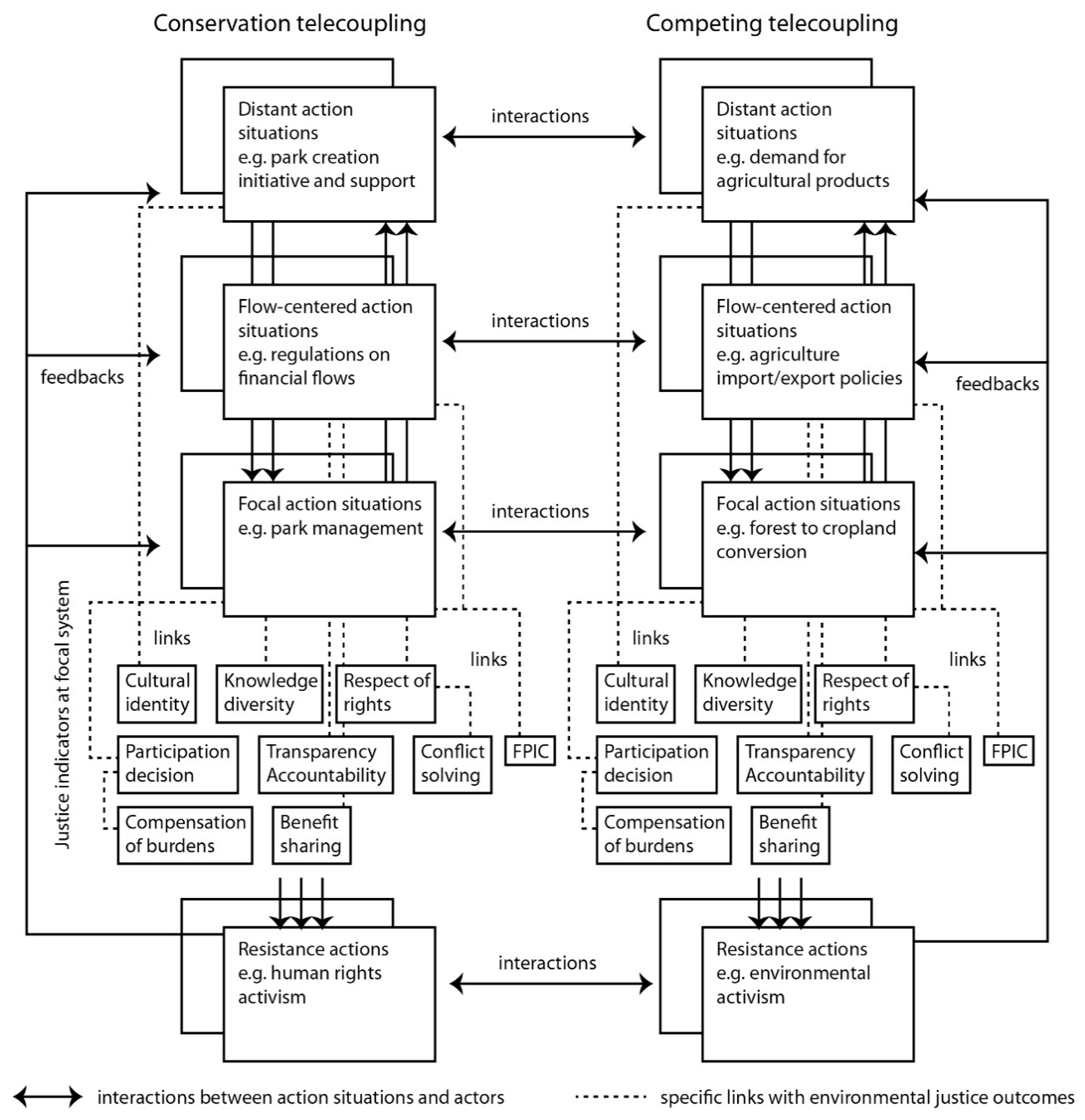
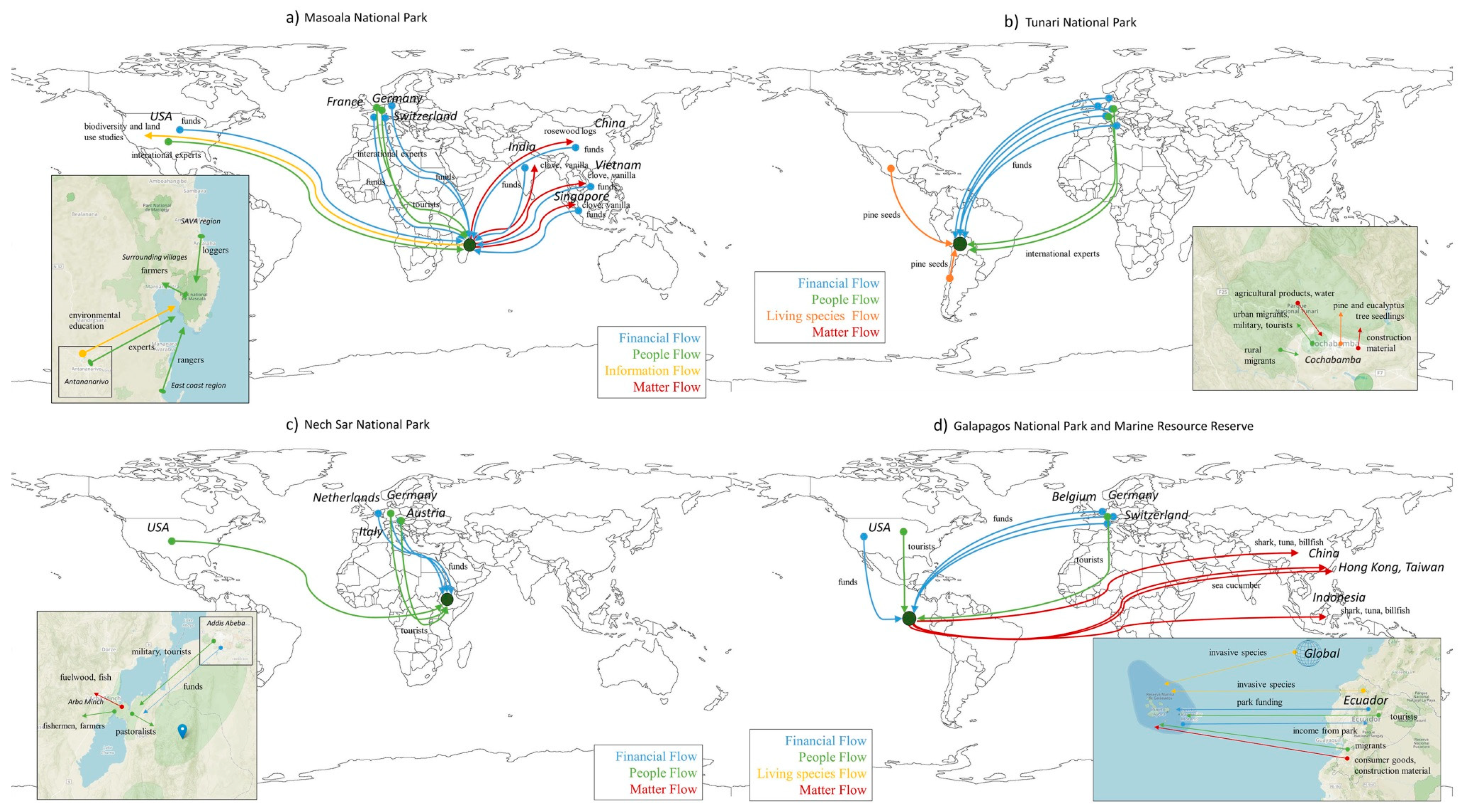

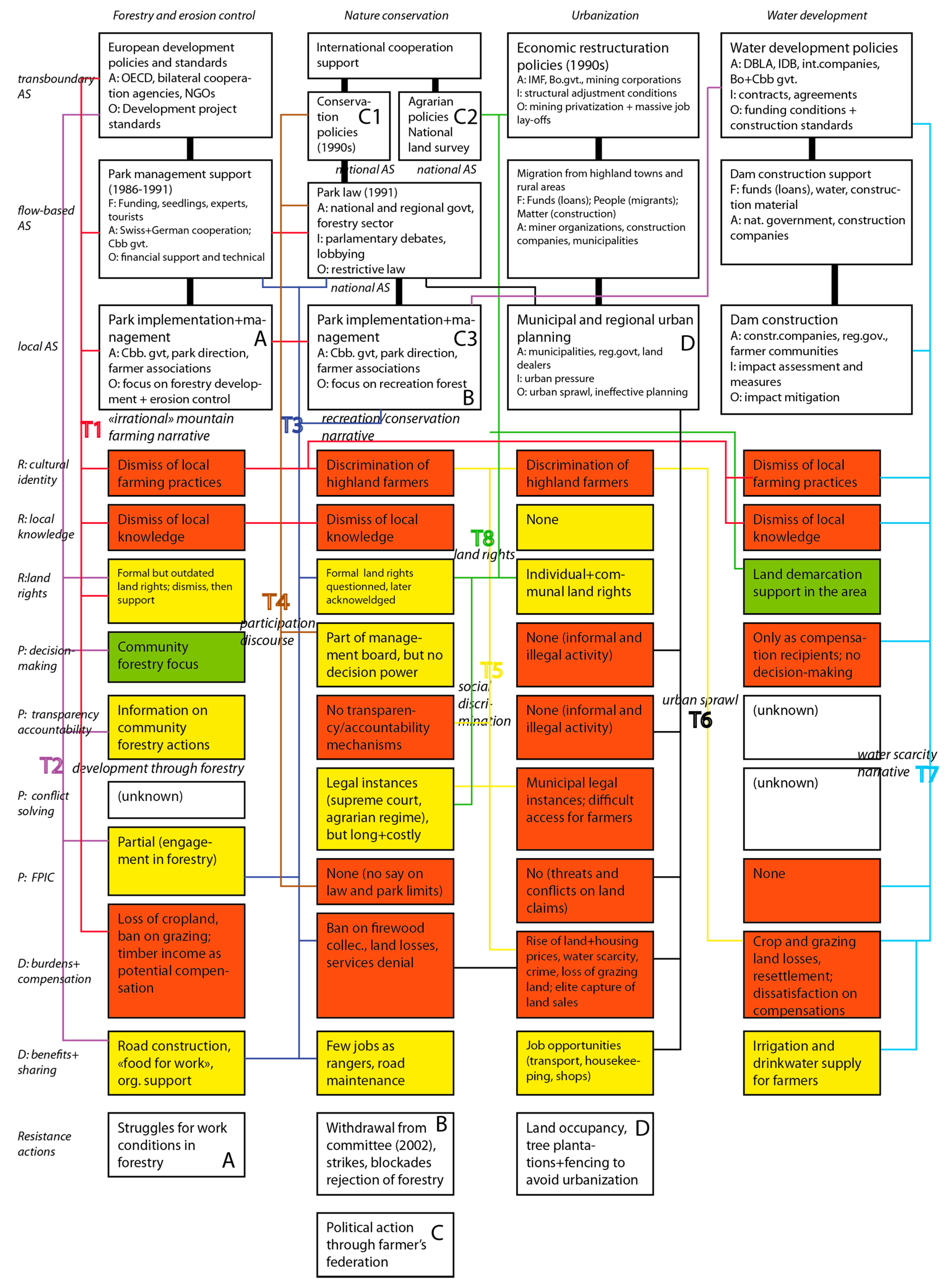
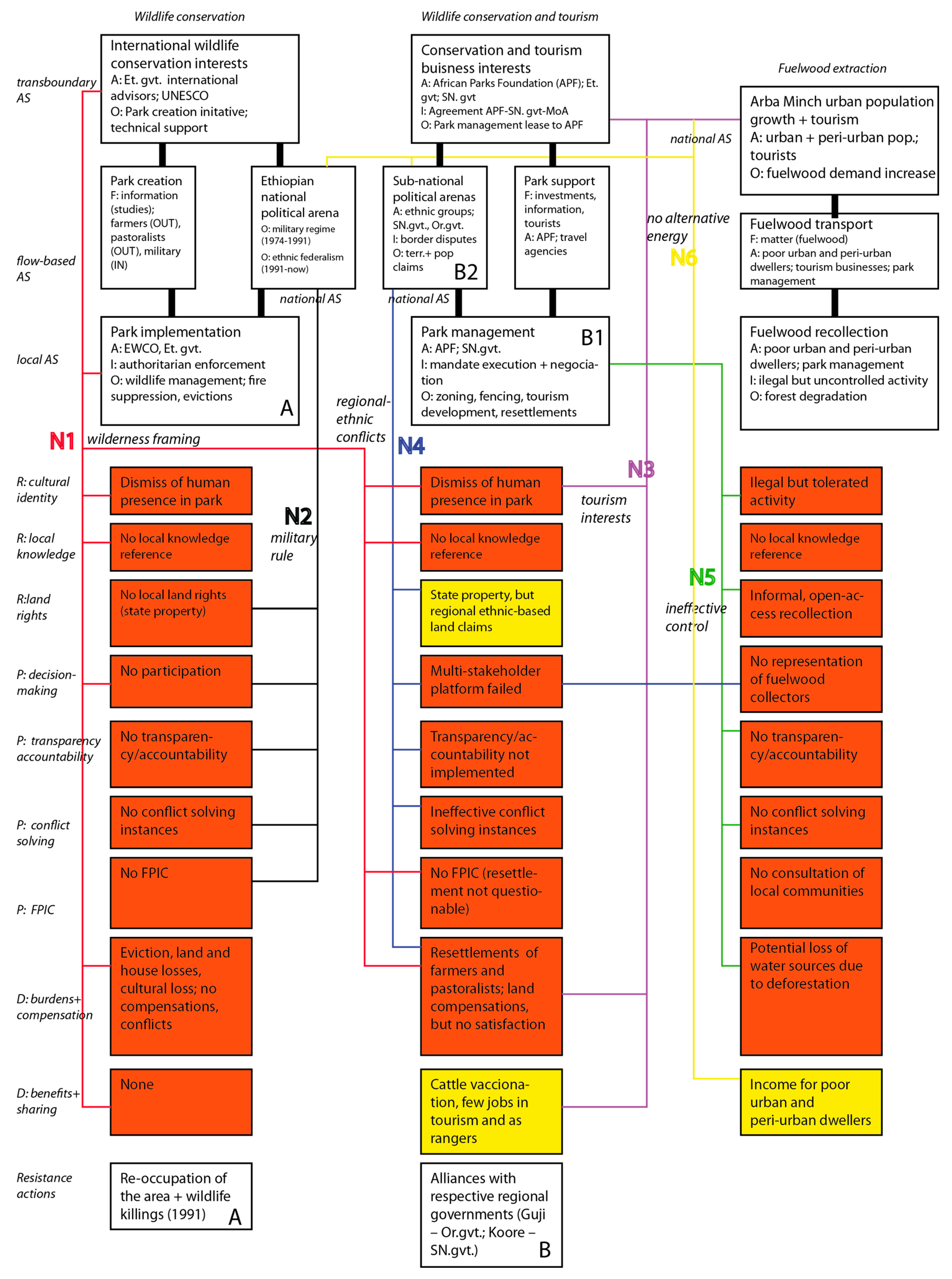
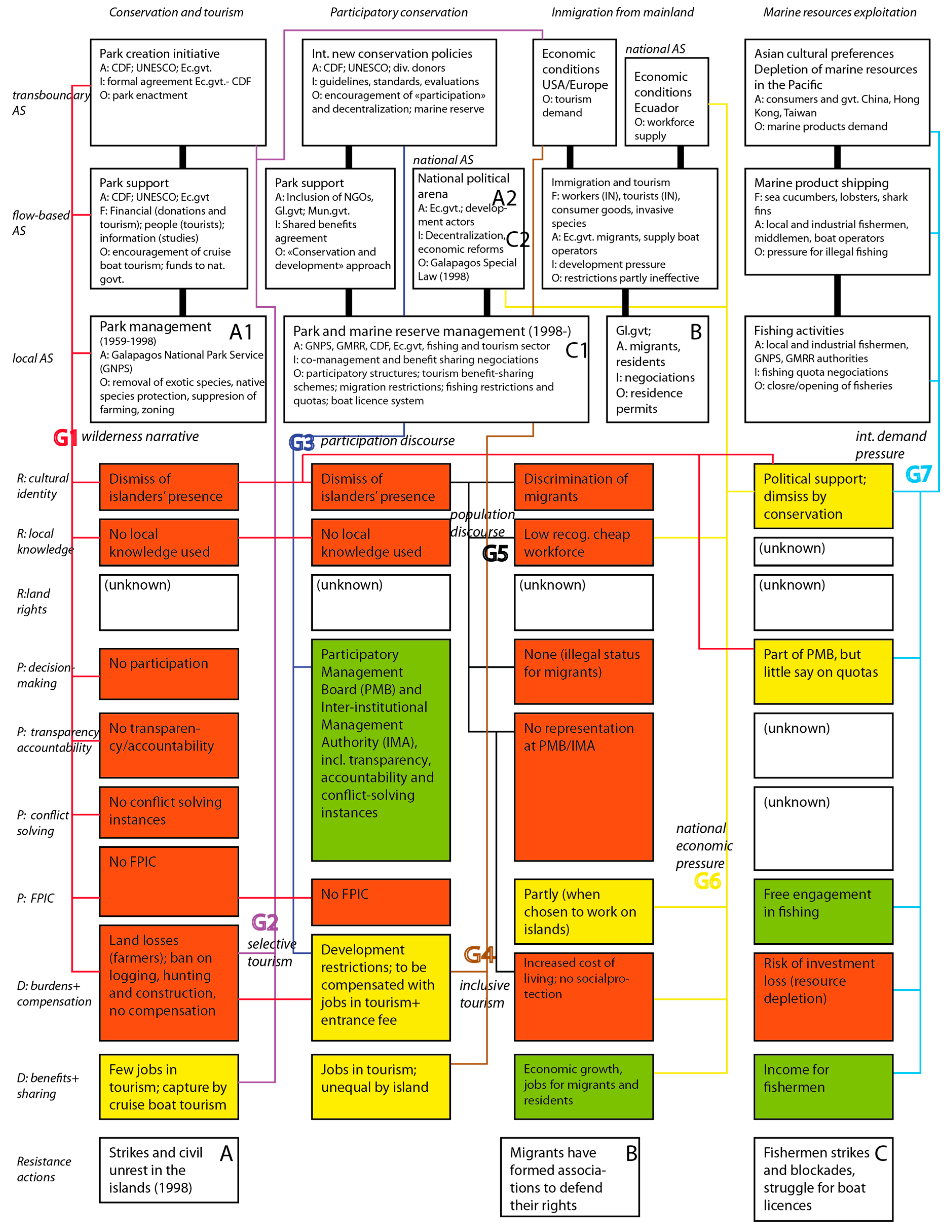
| Equity Criteria | Indicator | Key Question |
|---|---|---|
| Recognition | ||
| Cultural identity | Cultural identities of local stakeholders groups incorporated in the management of the PA | Have the cultural identities of local stakeholders groups contributed to the design and implementation of management actions in the protected area? |
| Knowledge diversity | Traditional knowledge systems included in the management of the protected area | Are traditional knowledge systems included in the management of the protected area? |
| Statutory and customary rights | Local stakeholders groups gain or retain their rights in the establishment or management of the protected area | Do local stakeholders groups retain their statutory and customary rights with the establishment or management of the protected area? |
| Procedure | ||
| Full participation in decision-making | Local stakeholders groups satisfied with how decisions are taken | Are local stakeholder groups satisfied with how decisions are taken in relation to protected area management? |
| Transparency | Local stakeholders groups accessing information about management and planning | Are local stakeholders groups able to access information about management planning? |
| Access to justice | Local stakeholders groups resolving satisfactory disputes due to protected area establishment or/and management by existing mechanisms | Are local stakeholder groups able to satisfactorily resolve disputes by existing mechanisms? |
| Accountability | Local stakeholders groups knowing to whom to raise concerns for solving issues related to management actions | Do local stakeholders groups know to whom to raise concerns for solving issues related to management actions? |
| Free, prior and Informed consent (FPIC) | Free, prior and Informed consent (FPIC) obtained | Has a Free, Prior and Informed Consent (FPIC) been obtained in the protected area? |
| Distribution | ||
| Burdens | Households of local stakeholders groups relieved of burdens through mitigation actions or comprehensively compensation of them | Are there actions to mitigate burdens to local stakeholders groups living in or near the protected area? |
| Benefits | Households of local stakeholders groups receiving tangible benefits from management actions in a way that respects culturally accepted distributional principles | Do households of local stakeholder groups receive benefits from management actions in a culturally accepted way of benefit sharing? |
| A. Characterization of Telecouplings |
|
| B. Environmental Justice Outcomes |
|
| C. Barriers, Opportunities and Resistance |
|
| Protected Area | Masoala National Park | Tunari National Park | Nech Sar National Park | Galapagos National Park and Marine Reserve |
|---|---|---|---|---|
| Country | Madagascar | Bolivia | Ethiopia | Ecuador |
| Year of creation | 1997 | 1962, 1991 (extension) | 1974 | 1959 (GNP); 1986 (GMR) |
| Total area | 2100 km2 | 3090 km2 | 514 km2 | 7996 km2/138,000 km2 |
| Total population (area and surroundings) | 115,000 people in peripheral zone (2012) | About 53,000 rural, 34,000 urban (2012) | About 9000 | 25,000 (2012) |
| IUCN category | II (National Park) | II (National Park) | II (National Park) | II (National Park) |
| Biome type | Tropical forest; tropical coastal | Tropical dry mountains | Savannah; tropical freshwater | Tropical coastal |
| Barrier | Link | Scale | Tied Systems | EJ Dimensions 1 |
|---|---|---|---|---|
| Wilderness framings | M2, N1, G1 | Transnational, National, Local | Europe, USA, International | R, (P) |
| Negative narratives about local uses | M1, N1, T1 | Transnational, National, Local | Central States; Int + local experts | R, (P) |
| Malthusian framings | T7, G5 | National | Central States, urban areas | R, (P) |
| Rhetoric participation | T4, G3 | Transnational, National | Europe, USA, International | P, (R) |
| Authoritarian rule | M4, N2 | National | Central States | P, (R) |
| Socio-cultural discriminations + conflicts | N4,T5 | National, Local | Regional and ethnic identities | R, P, D |
| Financial dependence | M3, T2, N3,G2 | Transnational | Europe + USA-country relation | D, (P) |
| Extractive demand pressure | M6, N5, G7, T6 | Transnational, National, Local | Asia, Europe, USA, Urban areas | D |
| Narrow development options | N6, G6 | Transnational, National | Urban areas | D |
| Tourism demand pressure | T3, N3, G2,G4 | Transnational, National, Local | USA, Europe, Urban areas | R, (D) |
| Action | Type | Actors | Target (Scale) | Success |
|---|---|---|---|---|
| Masoala National Park | ||||
| Avoid park projects | Passive resistance | Small farmers | Local | Partial |
| Block loggers | Active resistance | Small farmers | Local | No |
| CITES lobbying | International advocacy | International NGOs | Global | Yes |
| Track shipping companies | International advocacy | International NGOs | Transnational | Partial |
| Advocacy in China | Transnational advocacy | International NGOs | Transnational | Partial |
| Pressure government | Transnational advocacy | International NGOs | Transnational | Partial |
| Human rights advocacy | Transnational advocacy | Swiss and national NGO | Transnational | Partial |
| Tunari National Park | ||||
| Work conditions claims | Active resistance | Small farmers | Local | Yes |
| Board withdrawal | Passive resistance | Farmers association | Local | No |
| Forestry project withdrawal | Passive resistance | Small farmers | Local | No |
| National movement support | National politics | Farmers association | National | Partial |
| Land occupation | Active resistance | Small farmers | Local | Unknown |
| Place care narrative | Counter-narrative | Small farmers | Multiple | Partial |
| Nech Sar National Park | ||||
| Looting + wildlife killings | Violent actions | Pastoralists + Farmers | Local | No |
| Land occupation | Active resistance | Pastoralists + Farmers | Local | No |
| Fire suppression blame | Counter-narrative | Pastoralists | Multiple | Partial |
| Alliance with regions++ | National politics | Pastoralists | National | Partial |
| Galapagos National Park and Marine Reserve | ||||
| Looting + wildlife killings | Violent actions | Fishermen | Local | Yes |
| Alliances with national parties | National politics | Fishermen | National | Yes |
| Strikes, demonstrations | Active resistance | Fishermen | Local | Partial |
| Challenging “natural laboratory” | Counter-narrative | Fishermen | Multiple | No |
© 2018 by the authors. Licensee MDPI, Basel, Switzerland. This article is an open access article distributed under the terms and conditions of the Creative Commons Attribution (CC BY) license (http://creativecommons.org/licenses/by/4.0/).
Share and Cite
Boillat, S.; Gerber, J.-D.; Oberlack, C.; Zaehringer, J.G.; Ifejika Speranza, C.; Rist, S. Distant Interactions, Power, and Environmental Justice in Protected Area Governance: A Telecoupling Perspective. Sustainability 2018, 10, 3954. https://doi.org/10.3390/su10113954
Boillat S, Gerber J-D, Oberlack C, Zaehringer JG, Ifejika Speranza C, Rist S. Distant Interactions, Power, and Environmental Justice in Protected Area Governance: A Telecoupling Perspective. Sustainability. 2018; 10(11):3954. https://doi.org/10.3390/su10113954
Chicago/Turabian StyleBoillat, Sébastien, Jean-David Gerber, Christoph Oberlack, Julie G. Zaehringer, Chinwe Ifejika Speranza, and Stephan Rist. 2018. "Distant Interactions, Power, and Environmental Justice in Protected Area Governance: A Telecoupling Perspective" Sustainability 10, no. 11: 3954. https://doi.org/10.3390/su10113954
APA StyleBoillat, S., Gerber, J.-D., Oberlack, C., Zaehringer, J. G., Ifejika Speranza, C., & Rist, S. (2018). Distant Interactions, Power, and Environmental Justice in Protected Area Governance: A Telecoupling Perspective. Sustainability, 10(11), 3954. https://doi.org/10.3390/su10113954








